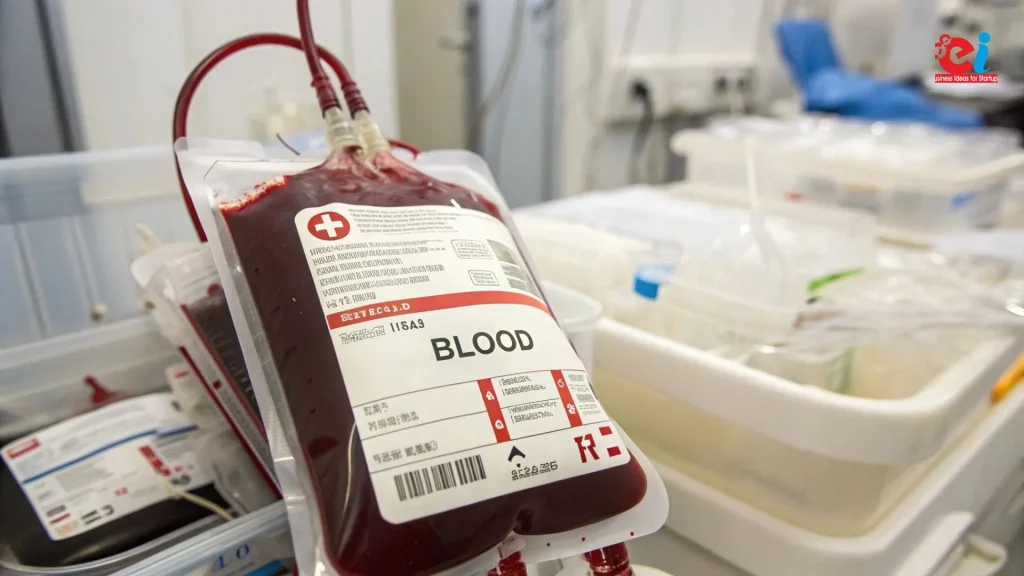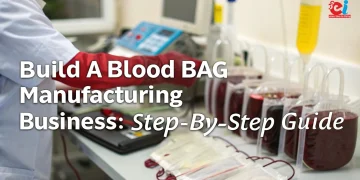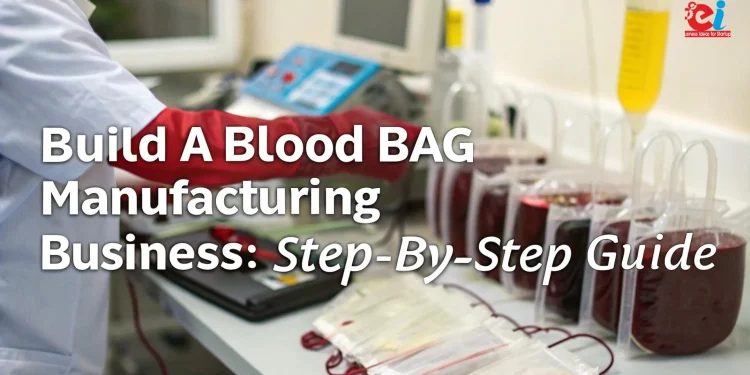The production of blood bag is perhaps one of the most highly specialized and intricate areas of grwoth in the medical devices industry. Blood bags are vital to the proper collection, preservation, storage, and transfusion of whole blood and its components. The need for reliable and safe sterile blood collection systems has never been more critical with the growing demands of hospitals, blood banks, trauma centers, and surgical units around the globe.
In the developing world, including India, the demand for blood bags is steadily increasing. These include organized healthcare infrastructure, rising voluntary blood donation, government-sponsored health insurance schemes, and the continuous development of emergency medical services. Therefore, establishing a blood bag manufacturing plant is not only a good business opportunity, but one that will help the public health infrastructure. However, starting up in this industry requires an understanding of the processes involved in manufacturing, raw materials, legal requirements, spending, and changes to foundational considerations.
Global Blood Bag Market Overview
Increased surgical procedures, maternal care services, accident cases, and an aging population with chronic illnesses have increased the use of blood components and blood bags. This has led to a dramatic increase in the consumption of blood bags which will have the global market anticipated to exceed 750 USD million by the year 2030.
The country expected to grow at the highest rate of USD shirt in the coming years owing to its large untapped population, increasing number of mobile blood collection units and blood forwards along with Indian government systems focusing on healthcare access will boost utilization for this sector. In addition, lower labor costs and easy compliance to international medical-legal standards enable Indian manufacturers to emerge as dominant players in the domestic market. This puts India in strong position not only as a consumer, but emerging exporter of blood bags to Africa, Latin America, South East Asia, and Middle Eastern countries.
Comprehending Blood Bag Variants
To meet the needs of the medical industry, a manufacturing plant should be capable of producing a variety of blood bags. These include single bags for collecting and storing whole blood, double bags for separating into red blood cells and plasma, and triple or quadruple bags for plasma, platelets, and cryoprecipitate separation. Some bags come with leukocyte filters for white blood cell removal for safer transfusions for immune-compromised patients.
Each variant has unique requirements with different combinations of tubing, ports, anticoagulant solutions, and packaging, as well as other custom requirements. There are complex hospital and clinical needs, so manufacturers need to maintain a diverse product line for both domestic and export markets.
Related: List of Profitable Manufacturing Business Ideas, Projects on Surgical
Sourcing of Raw Materials and Components
The effectiveness and safety of blood bags largely depend on the raw materials used, which need to be compatible and of good quality. Medical grade polyvinyl chloride (PVC) resin is the primary component which is used for making the flexible body of the bag. This grade of PVC should also be biocompatible, non-toxic, and stable under storage and sterilization conditions. Cooling plasticizers like DEHP or TOTM are used for added flexibility. While DEHP has been the norm, there is a shift, albeit slow, towards TOTM and other less reactive substitutes.
The blood flow channels, which have to be kink resistant and pinch resistant, also require tubing material which is generally flexible PVC or polyurethane. An integrated unit is also formed with stainless steel needles, clamps, connectors, and injection ports. In order to prevent clotting, anticoagulant solutions such as CPDA or SAGM are filled into the bags. All of these components also need to meet pharmacopeial requirements like USP, EP or Indian Pharmacopoeia, and also need to be sterilized using ethylene oxide (ETO) or gamma radiation.
Primary pouches and secondary cartons are examples of packaging materials that need to be protective and carefully designed to ensure that the sterile bags do not get contaminated during transit and storage.
The Manufacturing Process: Detailed Overview
Blood bag manufacturing is an exacting process which is done in a clean environment. Everything commences with a step known as film extrusion. At this stage, the PVC resin and plasticizers are heated, mixed and then extruded into medical grade PVC sheets. These sheets are the raw materials for the blood bags.
The forming of the bag comes after this. It entails cutting the sealed sheets and sealing them with RF (radio frequency) welding or ultrasonic welding. This allows for adding seams to the bags which need to be sterilized and remain intact throughout use. Ports that will be used for tubes later are also added at this stage.
Semi-automated devices join tubing, needles and connectors into the bags. The connecting of the needle has to be done in a clean room to avoid contamination. Once everything is put together, a blood bag is placed in an aseptic environment where predetermined amounts of anticoagulants are added.
For every step in the product’s lifecycle such as traceability, barcode, hospital record-keeping, and for other compliance purposes, labeling and barcoding are performed. Gamma and ethylene oxide sterilization are performed based on the sterilization steps utilized in manufacturing the product, as well as the shelf life of the product. Final packaging is initially performed in sterile environments, then terminal sterilization is performed afterwards.
The bags that have undergone sterilization are quarantined, then checked for sterility, leaks, and tensile strength along with being put under market release tests.

Facility Cleanroom Design and Infrastructure
Considering the bladder bag manufacturing process, the production plant should have cleanroom infrastructural facilities. The production region requires an ISO class 7 compliance, measuring at 10,000, while the needle assembly area, alongside anticoagulant filling should be placed at 5 or 6 cleanroom iso class. The space must contain positive pressure air control units, HEPA filters, climate control, and stainless steel furniture to mitigate microbial fueling.
For streamlining smooth material transfer from gathering raw materials to dispatching the finished product, unidirectional facility layouts are required. Areas dedicated to micromanagement such as extrusion, forming, assembling, tubings, sterilization, quality control, and storage should also be delineated. Other unused zones include those for HVAC systems, waste disposal, water purification, and air compression.
An inspection lab with quality control features is also required. It should do regular monitoring for burst strength, seal integrity, microbial, biocompatibility evaluations, as well as chemical leaching evaluations. These tests, in addition to being important for regulations, help safeguard brand image in the market in case of competition.
Related: How to Start a Manufacturing Business of Blood Collection Bags
Machinery and Equipments
It is clear from the description above that the productivity and efficiency of the plant is hinged on the quality of its machines. The extrusion line must include temperature control, automation, and output per your capacity. Forming units should permit high-speed RF welding with low rejection rates. Dose systems for anticoagulant filling, automatic needle assembly machines, and tube cutters add to the functionality of the plant.
Labeling, sealing, and packaging systems should be done with vision inspection systems to perform automated quality checks. Furthermore, calibrations and validations need to be done regularly for sterilization units such as gamma chambers or ETO sterilizers. The technical framework of the plant is complete with supporting systems like UPS, purification, air showers, and fire extinguishing systems.
Financing and Capital Investment
Setting up the international market entry plan will certainly require more capital in comparison to other capital blood bag manufacturing plants. A medium-sized plant that operates at an annual output of 5-10 million units would need approximately 25-40 crore Rupees. This amount covers the entire expenses of purchasing a site, installing the machinery and cleanroom, licensing, and paying utilities as well as working capital.
Investment return periods in these plants starts at something around 3-4 years, given there is an efficient production capacity, minimal product rejection rates alongside strong quality assurance measures in place. The profit return on investment is estimated at 20-30% considering the healthy profit margins derived from government tenders, hospital procurement service systems, and international distributors who offer considerable prolonged revenue ensuring contracts.
Licensing and Regulatory Compliance
As blood bags are categorized as Class C medical devices under India’s Medical Device Rules (MDR), 2017, they are subject to stringent licensing and audits. A license must be obtained from the Central Drugs Standard Control Organization (CDSCO) under the Directorate General of Health Services. For export, additional certifications such as CE marking, ISO 13485, and US FDA 510(k) registration may be required based on destination countries.
The plant must follow Good Manufacturing Practices (GMP) as per Schedule M-III of the Drugs and Cosmetics Act. Annual audits, batch-wise documentation, traceability of raw materials, and validation of each process stage are compulsory. Documentation covering risk analysis, design history, clinical data, and post-market surveillance also forms part of the regulatory landscape.
Role of NIIR Project Consultancy Services (NPCS)
Launching a blood bag manufacturing plant involves managing multiple technical, regulatory, and financial challenges. This is where NIIR Project Consultancy Services (NPCS) becomes a vital partner. With decades of experience in preparing industrial feasibility studies, NPCS provides tailored solutions for entrepreneurs entering the medical devices sector.
Their services include detailed project reports covering market research, capital expenditure, machinery selection, process flow diagrams, plant layout, manpower planning, and break-even analysis. NPCS also assists in navigating the regulatory process, identifying vendors for cleanroom and machinery, and offering post-launch support to improve productivity and quality.
Conclusion
Establishing a blood bag manufacturing plant is a forward-looking venture with immense scope for profitability, technological growth, and contribution to public health. As the demand for safe and efficient blood transfusion grows across India and globally, the opportunity for domestic manufacturers is larger than ever. However, success in this domain demands meticulous attention to quality, hygiene, compliance, and operational excellence.
Entrepreneurs willing to invest in precision, infrastructure, and regulatory frameworks can tap into this thriving market. With the support of institutions like NIIR Project Consultancy Services (NPCS), setting up a world-class blood bag production facility is not just feasible—it is strategically and financially rewarding.


























